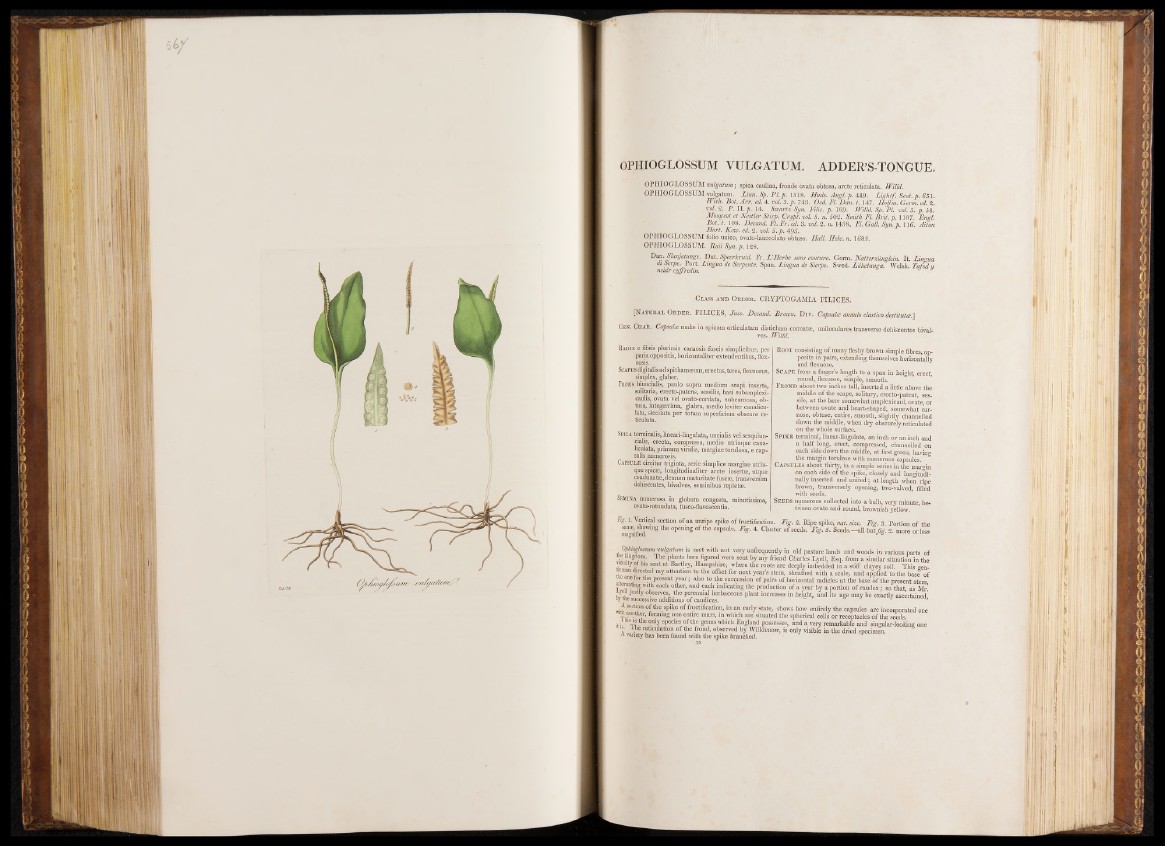
OPHIOGLOSSUM VULGATUM, ADDER’S-TONGUË.
OPHIOGLÖSSÜM vulgatum; spica Caulina, fronde ovata obtusa, arCte reticulata. Willd.
OPHIOGLOSSUM vulgatum. Linn. Sp. P l.p . 1518. Huds. Angl. p. 449. L ig h tf Scot. p. 65L
With. Bot. Arr. ed. 4. vol, 3. p. 743. Oed. Fl. Dan. t. 147. Hoffm. Germ. ed. 2.
vol. 2. P. II. p. 14. Swartz Syn. Filic. p. 169. Willd. Sp. PI. vol. 5. p . 58.
Mougeot et Nestler Stirp. Crypt. vol. 5. n. 502. Smith Fl. Brit. p . 1107. EngL
Bot, t. 108. Decand. Fl. Fr. ed. 3. vol. 2. n. 1438. Fl. Gall. Syn.p. 116. Alton
Hort. Kent), ed. 2. vol. 5. p. 495.
OPHIOGLOSSUM folio unico, ovato-lanceolato óbtuso. Hall. Helv. n. 1685.
OPHIOGLOSSUM. Raii Syn.p. 128.
Dan. Slanjetunge. Dut. Speerkruid. Fr. L ’Herbe
di Serpe. Port. Lingua de Serpente. Span. Ling
neidr cyffredin.
ns couture. Germ. Natterzünglein. It. Lingua
de Sierpe. Swed. Laketunga. Welsh. Tafody
Class a n d Ord e r . CRYPTOGAMIA FILICES.
[Natural Ord e r . FILICES, J uss. Decand. Brown. D iv . Capsula annulo elasticô destituta.']
Gen. Char. Capsula nudæ in spicam articulatam disticham conuatæ, uniloculares transverse déhiscentes bivalv
e s . , / ^ .
Radix e fibris plurimis carnosis fuscis simplicibus, per
paria oppositis, horizontaliter extendentibus, flex-
Scapus digitalis ad spithâmæum, erectus, teres, flexuosus,
simplex, glaber.
Frôns biuncialis, paulo supra medium scapi inserta,
solitaria, erecto-patens, sessilis, basi subamplexir
caulis, ovata vel ovato-cordata, subcamosa, ob- j
tusa, integerrima, glabra, medio leviter canaliculate
» siccitate per totam superficiem obscure reticulata.
Spica terminalis, lineari-lingulata, uncialis vel sesquiun-
cialis, erecta, compressa, medio utrinque caria-
liculata, primum viridis, margine torulosa, e cap-
sulisnumerosis.
Capsüiæ circiter triginta, serie simplice margine utrinque
spicæ; longitudiualiter arcte insertæ, atque
coadunatæ, demum maturitate fuscæ, transversim
déhiscentes, bivalves, seminibus repletæ.
Semina numerosa in globum congests, minutissima,
ovato-rotundata, fusco-flavesccntia.
Root consisting o f many fleshy brown simple fibres, opposite
Fig. l. Vertical section of an unripe spike of fructification,
same, showing the opening of the capsule. Fig. 4. Cluster
magnified.
in pairs, extending themselves horizontally
and flexuose.
Scape from a finger’s length to a span in height^ erect,
round, flexuose, simple, smooth.
Frond about two inches tall, inserted a little above the
middle o f the scape, solitary, erecto-patent, sessile,
at the base somewhat amplexicaul, ovate, or
between ovate and heart-shaped, somewhat car-
nose, obtuse, entire, smooth, slightly channelled
down the middle, when dry obscurely reticulated
on the whole surface.
Sp ik e terminal, linear-lingulate, an inch or an inch and
a half long, erect, compressed, channelled on
each side down the middle, at first green, having
the margin torulose with numerous capsules.
Capsules about thirty, in a simple series in the margin
on each side of the spike, closely and longitudinally
inserted and united; at leugth when ripe
brown, transversely opening, two-valved, filled
with seeds.
Seeds numerous collected into a bulb, very minute, be*
tween ovate and round, brownish yellow.
Fig. 3. Portion of the
Fig. 2. Ripe spike, not. size.
o f seeds. Fig. 5. Seeds
.—all bu t/g \ 2. more or less
Ophiaglossumvulgatum is met with not very unfrequently in old pasture lands and woods in' various parts of
U P f e The f e l ? here figured were sent by my friend Charles Lyell, Esq. from a similar situation in the
vicinity ol his seat at Bartley, Hampshire, where the roots are deeply imbedded in a stiff claVey soil. This gen-
leman directed my attention to the offset for next year’s stem, sheathed with a scale, and applied to the base of
me one lor the nresent venr: also tn flip cn/<ooccinn nf ..e __ ._ fl, r nl f°r present year; also to the succession o f pairs of horizontali radic1l _e_s _a^t th_e tb_ ase orf .t.he present stem
alternating with each other, and each indicating the production'of a year by a portion of caudex; so that, as Mr’
•oyeii justly observes, the perennial herbaceous plant increases in height, and its age may be exactly ascertained’
cne successive additions of caudices.
..j.f sec^on the spike of fructification, in an early state, shows how entirely the capsules are incorporated one
with another, forming one entire mass, in which are situated the spherical cells or receptacles of the seeds,
it is t! ^ sPeGie® ° f *he genus which England possesses, and a very remarkable and singular-looking one
a i f Bf tlGlJIat10“ o f *he .frond> observed by Willdenow, is only visible in the dried specimen.
a variety has been found with the spike branched.